Ready to proof -- 4/21/22
Reviewed by KP 4-22-22. Changes sent to Clare.
CLJ revised on 4/22. (Waiting for new photo in first item.)
KJ proofed on 4/22 and sent correction to Clare
CLJ revised on 4/22
INDUSTRY UPDATES
“Paint is one of the most expensive products for local household hazardous waste programs to manage,” said Lisa McDaniel of the Mid-America Regional Council Solid Waste Management District, one of the demonstration project partners along with the Missouri Department of Natural Resources. “Paint stewardship has the potential to relieve local governments and taxpayers of that financial burden while also supporting a vibrant recycling system.”
“Giving our historic buildings a much-needed facelift with recycled paint will honor our town’s heritage, while also demonstrating that leftover paint can be transformed into new recycled paint that is comparable to virgin paint,” said Melissa Mau, City Clerk for Ash Grove.
Paint demonstration sites include the Missouri State Parks Central Warehouse at Lake of the Ozarks; historic buildings in downtown Ash Grove; the Discovery Center (lobby and Sprouts Discovery Preschool exterior) in Springfield; and the City Hall offices and lobby, and the police station at the Municipal Center in Ashland. Additional sites will be unveiled this summer and fall.
BOSTON – The Missouri Product Stewardship Council (MO PSC) and the Product Stewardship Institute (PSI) recently added new sites to their series of recycled paint demonstrations throughout Missouri. The demonstration series, “Recycled Paint: Better for Your Pocket and the Planet,” will now feature a set of historic buildings in Ash Grove and the Missouri State Parks Central Warehouse at Lake of the Ozarks. Painting kicked off in Ash Grove on Friday, April 22, and will begin at the State Parks Warehouse in May.
“These demonstrations showcase the high quality, low cost and sustainability of recycled paint,” said Scott Cassel, CEO and founder of PSI. “We’re excited to be partnering with the Missouri Product Stewardship Council and two of North America’s most experienced recycled paint manufacturers to help people recognize the value of recycled paint while also reducing paint waste.”
Recycled paint manufacturers GDB International and Amazon Paint donated the paint being used at each site. The recycled paint demonstrations aim to inspire support for product stewardship for paint in Missouri. Product stewardship is a policy that holds companies responsible for the full life cycle of products they put on the market, including funding for the collection and recycling of unused paint.
Missouri Demonstrates Advantages of Recycled Paint at Various State Sites
Photos courtesy of Melissa Mau, City Clerk of Ash Grove, MO.
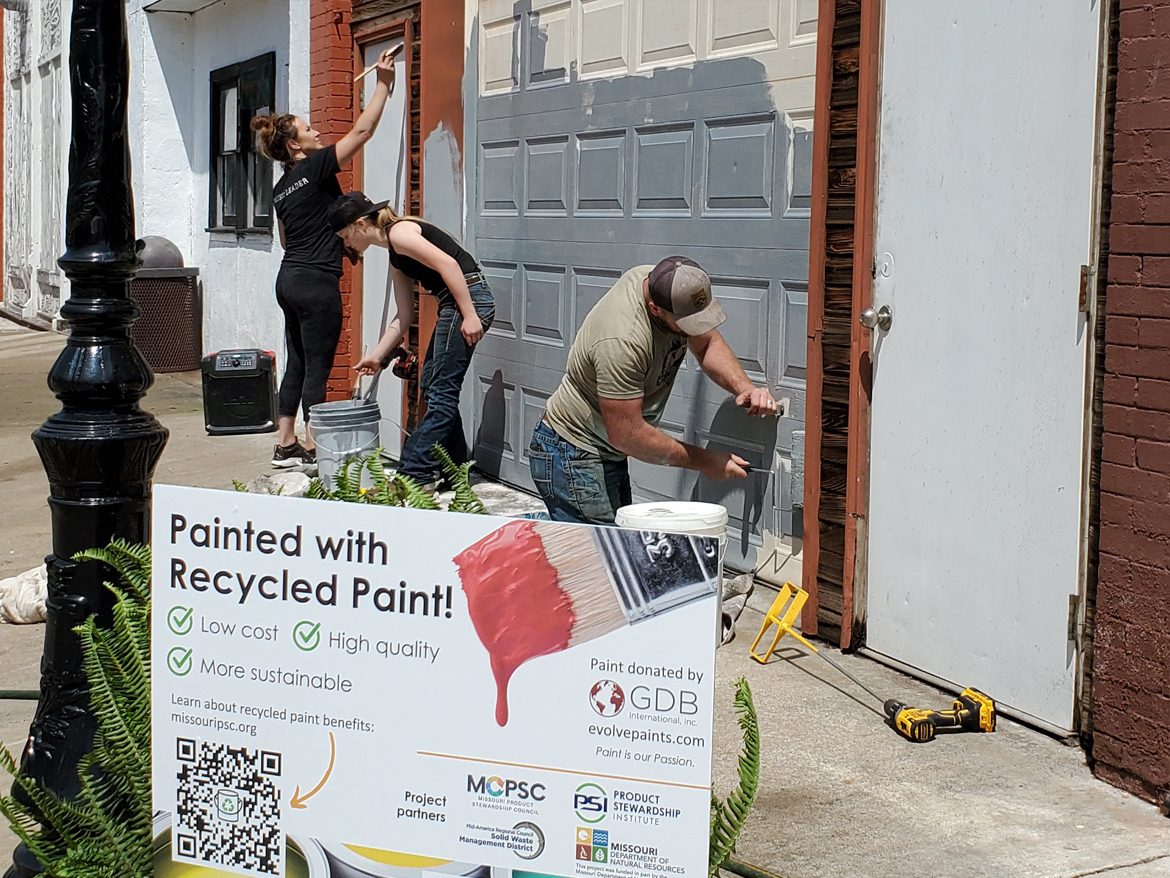
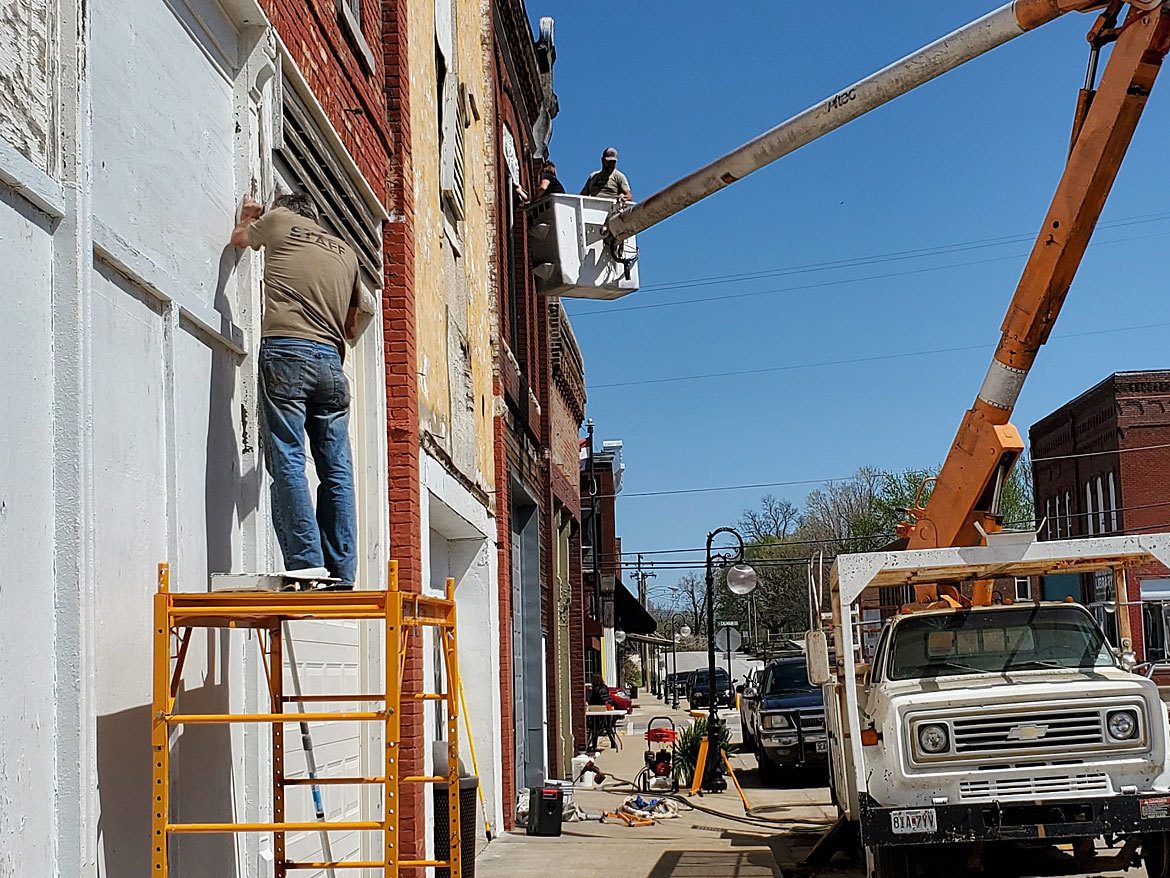

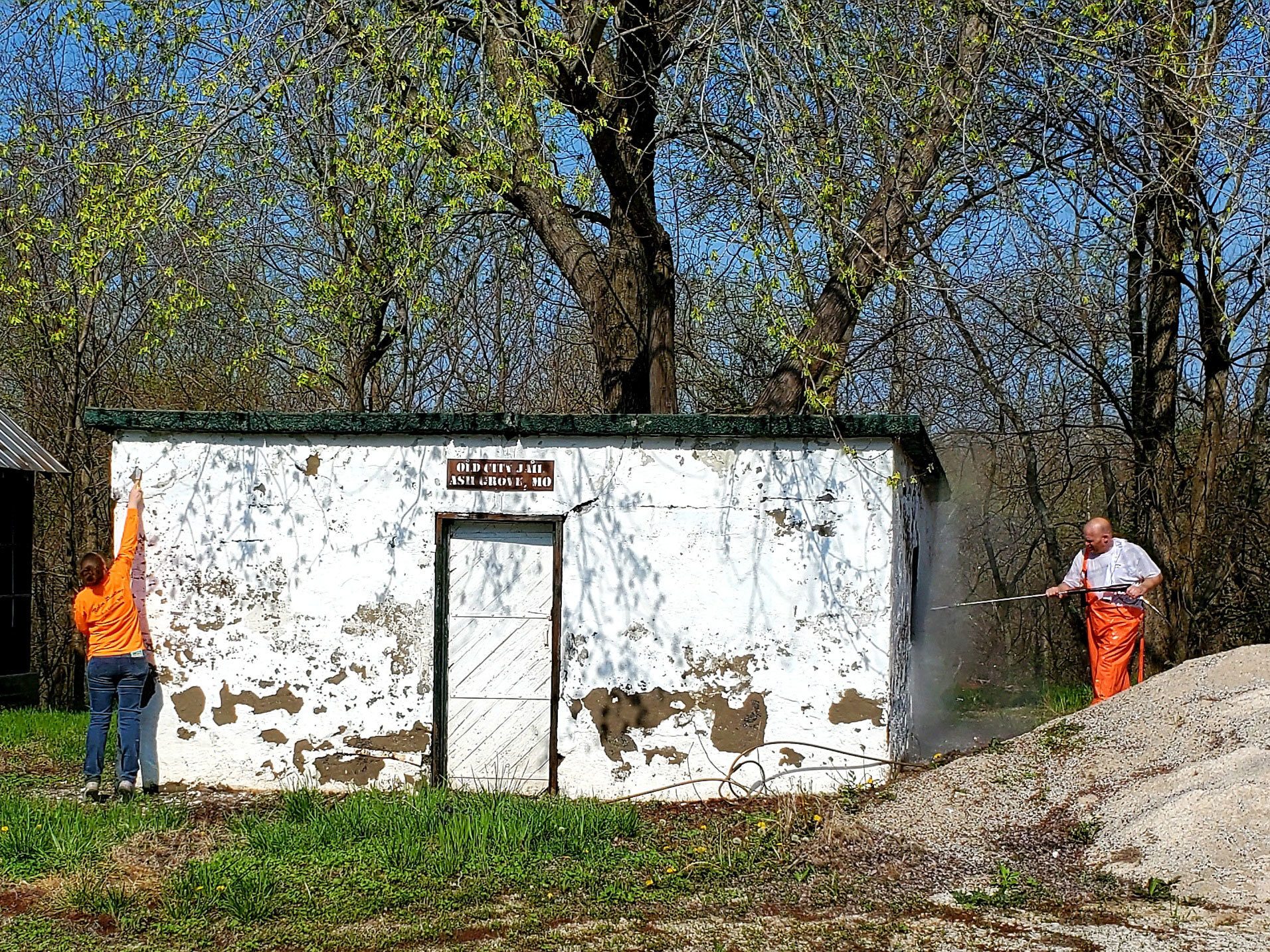
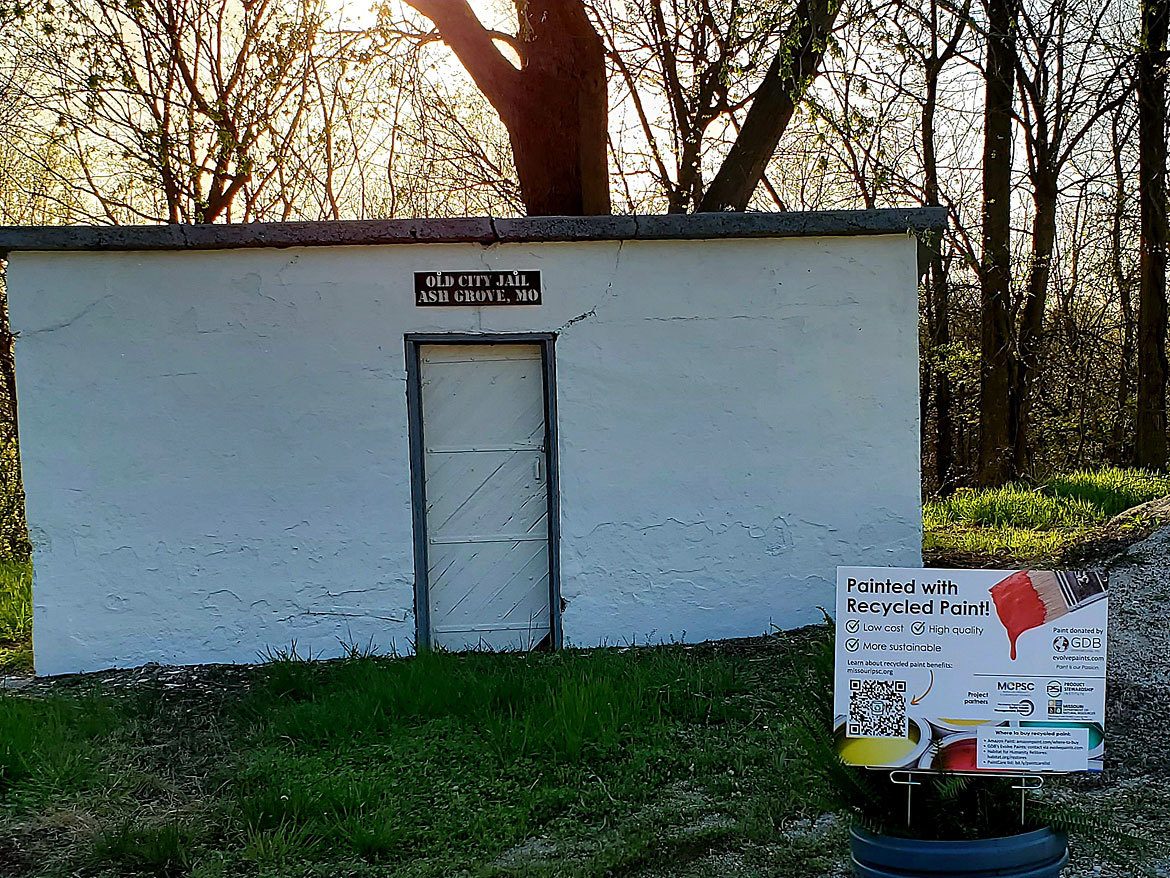
Click the arrows to view a slideshow of photos
Researchers at Texas A&M Develop Eco-Friendly Coating that Limits Flammability of Wood
SAN DIEGO – At the spring meeting of the American Chemical Society (ACS), researchers from Texas A&M presented results on a new type of coating that could limit the flammability of wood used in construction, potentially providing more time to escape fires and also curbing their spread. The environmentally friendly flame retardant could also be used for other flammable materials, such as textiles, polyurethane foam and 3D-printed parts.
Home fires account for the majority of fire deaths and lead to billions of dollars in property damage every year, according to the National Fire Protection Association. Adding fire sprinklers and smoke detectors can help, but another approach is to make construction materials less flammable. That’s the goal of Thomas Kolibaba, Ph.D., who is developing a new coating for these materials. “This type of treatment, which could be deposited via dipping, spraying or pressure treatment, could make homes much safer,” he said. “The coating could reduce flame spread and smoke production, which could limit damage and give people more time to evacuate.” Unlike most current fire retardant treatments, its ingredients are environmentally benign, and it might also cost less, notes Jaime Grunlan, Ph.D., the project’s principal investigator.
Kolibaba carried out the research as a graduate student and postdoc in Grunlan’s lab at Texas A&M University, building on polyelectrolyte coating technology invented by the group in 2009 and later extended by other researchers. Most of these coatings are formed by dipping fabric or other items in a solution containing one polymer with lots of positive charges on it, followed by a dip in another solution containing a polymer with lots of negative charges, and then repeating these steps to reach the desired thickness. The opposing charges draw the polyelectrolyte molecules in the alternating layers together into complexes on the item’s surface, forming a coating that can extinguish a flame.
Image courtesy of the American Chemical Society.
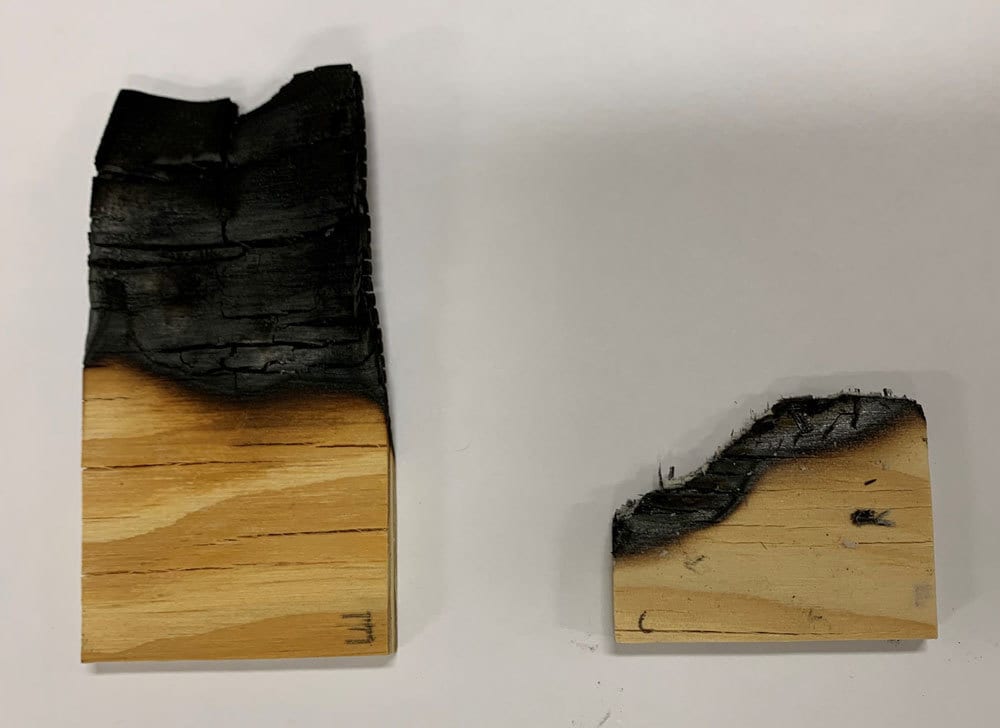
Kolibaba wanted to extend this treatment to wood, but the multistep process wasn’t feasible for manufacturers because wood takes too long to soak up these chemicals. Through further research he adapted another Grunlan technique, thereby cutting the number of steps down to two: one dip to coat the wood, followed by a dip in a different solution to cure the coating by changing the pH. But that second solution kept turning into a sticky mess, so the streamlined process still wasn’t convenient for industrial or consumer applications.
In the latest modification, which was presented at ACS Spring 2022, Kolibaba overcame that problem with a procedure that he said would be easy for industry or consumers to adopt. He dipped plywood in an aqueous solution containing the positively charged polymer polyethylenimine (PEI), the monomer hydroxyethyl methacrylate phosphate (HMP) and a photoinitiator known as TPO. Instead of dipping the wood in a second solution to cure, he exposed it to ultraviolet (UV) light for a few minutes. That caused TPO to turn the HMP into a negatively charged polymer, which then formed a polyelectrolyte complex with PEI. The resulting coating was transparent and only a few micrometers thick, so it didn’t change the wood’s appearance and added only slightly to its weight.
In lab flame tests, the treated wood lowered the amount of heat released during burning and quickly formed a surface layer of char that protected the underlying wood — features that could limit fire damage and spread. “It also reduced smoke production by 56%, an unusually large degree,” Kolibaba explained. Unlike the team’s prior coatings, which are held together by ionic bonds, this one is covalently bonded. So Grunlan expects it to be water-resistant — and therefore durable — and possibly also water-repellent and antifungal.
Industrial users could coat construction materials, such as wooden studs and other framing, or oriented strand board (a type of engineered wood similar to particle board). Homeowners could use a backpack sprayer to protect existing structures such as fences or barns, which have been shown to propagate wildfires, Kolibaba said. Other potential applications include textiles and polyurethane foam for clothing, home furnishings, and the automotive and aviation sectors, Grunlan said. The UV-curable polyelectrolytes could also be used as a resin to make 3D-printed parts, which are flammable when made with conventional resins. That could be particularly beneficial in aerospace settings, such as the International Space Station, Kolibaba explained.
Tom Bowtell Elected President of the World Coatings Council
MANCHESTER, UK – At the World Coatings Council’s annual meeting in March 2022, Tom Bowtell, Chief Executive of the British Coatings Federation (BCF), was elected President for a two-year term of office.
The World Coatings Council is made up of members representing associations from the United States, China, European Union, Brazil, Mexico, Australia, New Zealand, Japan, Malaysia, Canada, South Africa, Turkey, France, Germany and the United Kingdom. The council provides a forum for exchange and cooperation on major issues and priorities facing the industry, and has reportedly established itself as a global voice with the United Nations, governments and NGOs for over 30 years.
Bowtell commented on the new position, “I’m incredibly honored to have the trust of my industry colleagues from across the world to hold the President’s seat on behalf of the global coatings industry. I am looking forward to representing the industry and contributing to our global effort.”
Sustainability will be an important theme of Bowtell’s presidency, as the World Coatings Council is publishing its first Sustainability Report later this year.
Andy Doyle, President of the World Coatings Council and CEO of the American Coatings Association, said, “I am thrilled that Tom has accepted the role of President of the World Coatings Council. He is a global leader not only in the association community, but in the coatings industry as well. Tom along with the WCC’s new Vice President, Monica Alcala of the Mexican Paint and Printing Ink Manufacturers’ Association (ANAFAPYT), will do a fantastic job leading our organization. As the WCC celebrates its 30th anniversary in 2022, I can think of no one better suited to represent our industry on a world stage.”

Tom Bowtell, Chief Executive of the British Coatings Federation and the newly elected President of the World Coatings Council.
Research Project to Study Thermal Recycling Methods for Functional Coatings
SWANSEA, UK – A research project in the UK that aims to bring a truly circular economy one step closer has received a £1.2 million research grant from the Engineering and Physical Science Research Council (EPSRC). The three-year TReFCo (Thermal Recovery of Functional Coatings) project, which started in April, will investigate thermal recycling methods for functional coatings and develop wavelength-sensitive adhesives that will “unglue”’ when subject to certain types of radiation.
Dr. Jenny Baker, who is leading the project, explained why the research is needed, “When devices such as computers, smart phones and batteries are sent for recycling, not all the materials are captured for use in new devices.
“Specialist coatings are often made with rare and expensive materials to enable our modern electronics to work. However, these coatings can cause problems when it comes to recycling, and the materials are not always recovered but incinerated to produce ‘heat from waste.’ This means that the expensive, highly engineered coating has been lost and its value not realized.
“Adhesives often make our phones water-tight and ensure longer lifetimes of electronic products, however when it comes to recycling these products, the adhesives make it difficult to take the products apart; wavelength-sensitive adhesives would make this more straightforward.”
TReFCo aims to develop a low-cost method for removing these coatings so that they can be reused to make new devices. This will have multiple benefits; it will mean that valuable raw materials are kept within the supply chain. It will also mean that the materials that they were coated on are cleaner prior to their recycling process, ensuring a purer recycled product at a lower cost.
A lifecycle analysis will be undertaken to ensure that researchers fully understand the environmental costs of producing materials and recycling them. This will identify any areas that are environmentally damaging so they can be avoided by material design or by changing the processing methods.
The project is a collaboration in which Swansea University is partnering with the University of Birmingham, Keeling and Walker, Precision Varionic, Deregallera, Tata Steel, adphos Group, Elemental Inks & Chemicals, WRAP and Plug Life Consulting.
Dr. Gavin Harper, from the University of Birmingham, said, “We are looking at conducting detailed techno-economic comparisons between the TReFCo technology and other recycling technologies that are available. We believe that the TReFCo process could offer many advantages through being a dry, low-energy process that will be well suited to some recycling applications."

Graphite nanomaterial powder for use in conductive coatings. Image courtesy of Swansea University.
ACA Announces New Board Appointments
WASHINGTON – The American Coatings Association recently announced new leadership appointments to its board of directors. Dan Calkins, Chairman and CEO of Benjamin Moore & Co., will serve as ACA Chairman; and Jeffrey J. Powell, President and CEO of Diamond Vogel Inc., will serve as ACA Vice Chairman and Treasurer. In their roles, Calkins and Powell will provide strategic direction on association finances, and organizational and policy initiatives. Both Calkins and Powell will serve two-year terms, ending in April 2024.
Calkins was named Chairman and CEO of Benjamin Moore in January 2019, after serving as President and COO. He has been with the company for 34 years and has held a series of progressively influential and responsible positions within sales leadership, forging alliances with independent retailers that resulted in growth for both them and the company. Calkins served on the board of Alpha Workshops, the nation’s only nonprofit organization providing decorative arts education and employment to at-risk youth and adults with disabilities or other vulnerabilities.
Powell joined Diamond Vogel in October 2016 as an Executive Vice President and transitioned to his current role in 2019. He began his career in 1991 as a coatings sales representative for PPG Industries Inc., advancing through multiple sales and management positions before leaving in 2004 to join Jones-Blair Co. in Dallas, Texas. Powell managed Jones-Blair’s Industrial Coating business, became Vice President of Sales, and was named President and CEO in 2008. In 2014, Hempel North America acquired the Jones-Blair Co., and Powell became President of Hempel North America.
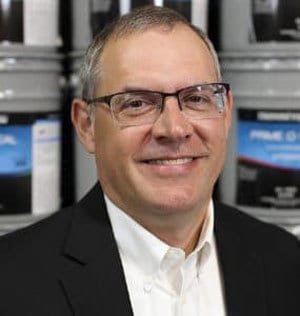

Dan Calkins, Chairman and CEO of Benjamin Moore & Co.; and Jeffrey J. Powell, President and CEO of Diamond Vogel Inc.
